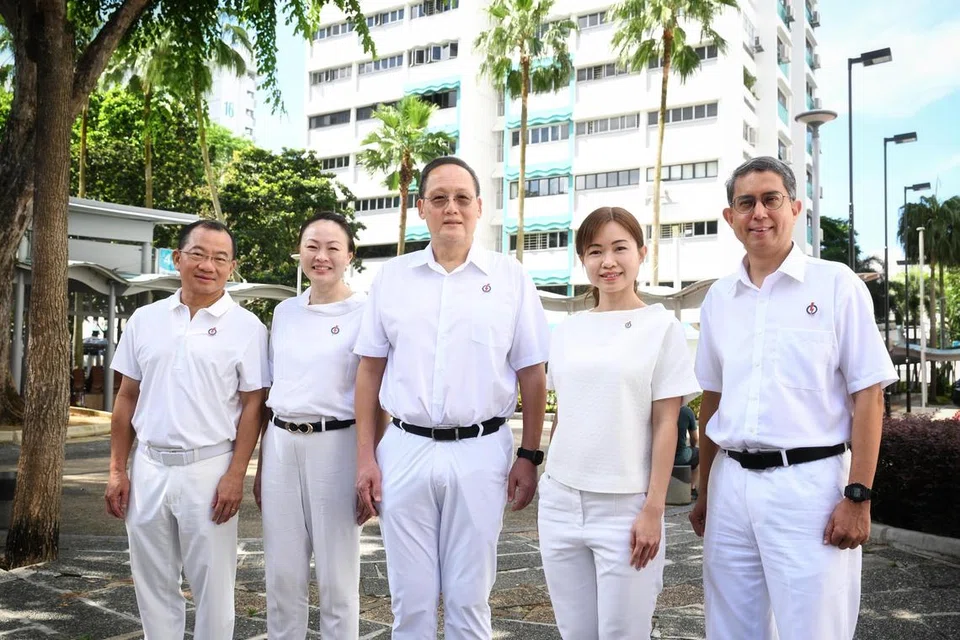- Joined
- Jul 25, 2008
- Messages
- 13,701
- Points
- 113
GE2025, island edition: Pulau Ubin’s elderly voters and their election stories

Thirty or so residents continue to live on Pulau Ubin, which will be part of the new four-member Pasir Ris-Changi GRC.ST PHOTO: BRIAN TEO
Shawn Hoo
Apr 20, 2025
SINGAPORE – Lifelong Pulau Ubin resident Ong Kim Cheng, 67, loves his island idyll and is happy to forgo most of the urban conveniences that Singaporeans enjoy. But the one municipal concern he brings up ahead of the general election proves that Ubinites are not that different from mainland urbanites after all.
The former quarry worker would like a covered walkway built between Changi Point Ferry Terminal – where the bumboats from Pulau Ubin dock – and Changi Village Hawker Centre, where he buys his groceries twice a week. Right now, he says in the wake of a recent monsoon surge, he gets drenched whenever it rains.
Mr Lim, a fellow Ubinite who declined to disclose his full name, has a fraught relationship with the teeming forest surrounding his home that will sound familiar to city dwellers. The 81-year-old and his wife have, in recent years, been besieged by an overpopulation of feisty macaques, which gobble up their durians, leaving nothing but empty husks.
Neither Mr Ong nor the Lims have found a solution to their woes despite raising them with the various authorities. Still, they and about 30 senior residents choose to live on Ubin, where amenities are minimal and some problems intractable because they are used to their disappearing way of life.
For Mrs Lim, a retired cleaner, the “outside world” – what Ubinites call the mainland – is a less-than-genial place where “everyone shuts their doors and is anonymous”.
Mr Ong, a bachelor who drives the occasional tourist around in his PU-licence-plate taxi van, relishes the stress-free life.
“We live day to day,” he says.

Like every other Singaporean, the 30 or so senior residents on Pulau Ubin, including 67-year-old lifelong Ubinite Ong Kim Cheng, will vote in the upcoming general election on May 3.ST PHOTO: SHAWN HOO
Like every other Singaporean, Ubinites will go to the polls on May 3. Part of the fiercely contested East Coast GRC in 2020, the island is now part of the newly formed Pasir Ris-Changi GRC in the upcoming election.
To cast their votes, residents here will have to pay $8 for a round-trip ferry ride to the mainland – up from $6 in pre-Covid-19 pandemic times.
During the 2020 election, the fare hike spurred artist and former disaster relief worker Terence Tan to fork out a few hundred dollars to charter two ferries and four cars to fetch residents to their polling stations, including the Singapore University of Technology and Design in Changi.
Mr Tan, 44, has been visiting the island regularly since he held his wedding there in 2018. The artist, who has helped residents with matters such as medical care and first aid training, says: “Thanks to them, the island is preserved – they are our heritage heroes.”
But he adds: “They need a lot more basic amenities. There’s no clinic, for example, and the residents are getting older.”
Residents receive their mail weekly on Thursdays from a postman who takes the ferry from Changi Point Ferry Terminal and walks around to the various houses on the island, he says.
Up until 1999, Pulau Ubin – which is nearly the size of Sengkang town – had active quarries holding the granite used to build the Istana and the Singapore-Johor Causeway. Its hilly terrain is broken up by lush mangroves, open meadows and towering trees such as the common pulai, which shoots 40m skyward.
Mr Tan has not decided if he will again arrange and pay for transport for Ubin residents to cast their votes this time around. He says he will wait until their ballot papers arrive ahead of GE2025 as their polling stations might have changed and the senior residents might need help with directions.
Islanders whom The Straits Times spoke to on a scorching afternoon on April 15 were aware that their incumbent East Coast GRC MP Maliki Osman would not be running in the constituency in GE2025, and that they would instead be voting under the newly formed Pasir Ris-Changi GRC.

Postman Shahruddin Datok delivering a letter to the Season Live Seafood Restaurant (left) on Pulau Ubin in 2021.PHOTO: ST FILE
Mr Ong recalls the tight contest in GE2020, when the PAP won 53.39 per cent of the vote. He does not intend to attend any political rallies and believes life on Ubin will likely plod along in its own languid way – no matter the outcome on Polling Day.
He recognises, however, that his remote existence cannot be separated from the economic trends on the mainland.
“Who I am voting for is not going to make much of a difference. The cost of living will continue rising,” he says.
Mr Ong is speaking to ST in “Orchard Road” – not the mainland’s shopping belt, which he last visited three decades ago, but the island’s pierside town centre. The hyperbolic moniker might suggest Ubinites have a sense of humour, but it is not entirely tongue in cheek: The island enjoyed a brief influx of visitors not too long ago, giving Ubinites a taste of mainland buzz.

Taxi van drivers gathering at the pick-up point on Pulau Ubin’s “Orchard Road”. There are 11 taxi vans on the island, although the visitor levels have dipped since the Covid-19 pandemic.ST PHOTO: BRIAN TEO
Mr Heng Buck Lim, 70, who drives one of 11 taxi vans on Pulau Ubin, recalls the days during the Covid-19 pandemic when more than 1,000 “mainlanders” flocked to Ubin to walk and breathe free in the great outdoors amid travel restrictions. These days, visitors number only 200 to 300 on a good weekend – and his income has taken a hit.
The gregarious driver hopes for a tourism revival on the sleepy island. Currently, he drives mostly biodiversity researchers and students around Ubin.
“It’s difficult when Ubin is under the care of NParks (National Parks Board). It might be better if the Singapore Tourism Board comes in and develops the place with attractions such as cable cars. Just look at how Sentosa became what it is today,” he says. It is an issue he has raised constantly, but he also acknowledges it is unlikely to happen.
Madam Ong Ang Kui, who runs Ah Ma Drink Stall on Ubin, agrees that boosting the number of attractions would help her small business. The 86-year-old estimates that visitors currently spend at least $50 each on the ferry ride, bicycle rental and food. More attractions, she says, would make the place more tourist-friendly.

Mr Heng Buck Lim, a 70-year-old taxi van driver, and Madam Ong Ang Kui, an 86-year-old drink seller, are two Ubin residents who hope for more tourism to boost their business on the island. ST PHOTO: SHAWN HOO
Still, islanders acknowledge the improvements they have seen over the years, such as new roads that lead up to their houses. The five residents ST spoke to recall regular visits by their well-loved MP, Dr Maliki, ever since he represented the Siglap division in 2011. They also met Senior Minister Teo Chee Hean and his PAP Pasir Ris-Changi team for the first time on April 11.
In GE2020, candidates from the Workers’ Party’s East Coast team also visited Ubin. The residents have yet to see candidates from the Singapore Democratic Alliance, which indicated it will contest Pasir Ris-Changi GRC in 2025.
For the Lims, Dr Maliki had made a difference. When wild boars killed two of their three dogs, Dr Maliki – who is also Minister in the Prime Minister’s Office – helped them secure a fence around their house. He also showed up with blankets during a recent cold spell in Singapore.
Rising costs, however, have affected them and other islanders. Mr Lim’s monthly electricity bill is about $135 a month, higher than the $90.01 an average four-room HDB household typically pays. Rental for the land now costs more than $1,500. In 2013, the annual rent was between $72 and $420.

The PAP team, including Senior Minister Teo Chee Hean (far right), conducted a walkabout on Pulau Ubin, which is under the the newly drawn Pasir Ris-Changi GRC, on April 11.ST PHOTO: BRIAN TEO
With no young residents left, it has become a super-ageing island. Most of Ubin’s remaining residents either travel to the mainland to see their loved ones or play host to family and friends on weekends.
Madam Ong confesses: “I don’t know if anyone will continue to live on Ubin, but I think there will be fewer and fewer people in the future.”
As Mr Heng points out during a village drive, many houses are now unoccupied or boarded up because their residents have moved to the mainland or died.
Mrs Lim says wryly: “There have been fewer people and more macaques.”
On the mainland, Ubinites say they sometimes feel invisible. One resident – who did not want to be named – recalls having trouble claiming CDC vouchers.
“They told us that our area does not exist, but I told them that we receive the letters to vote,” she says, adding that the oversight was eventually sorted out.
![Residents of Pulau Ubin queuing up at Pulau Ubin CC polling station to cast their votes in the general election. [General Elections 1972] Residents of Pulau Ubin queuing up at Pulau Ubin CC polling station to cast their votes in the general election. [General Elections 1972]](https://cassette.sphdigital.com.sg/image/straitstimes/a52b592934fb488a713344c54d6090f0082069adb1c17ca5b789a9958f4be67b)
Residents of Pulau Ubin queuing up at the Pulau Ubin Community Centre polling station to cast their votes in the general election in 1972.PHOTO: ST FILE
Ubin housed as many as 2,000 residents during its heyday in the 1950s.
At the 1972 General Election, they cast their votes at the polling station at Pulau Ubin Community Centre, which has since been repurposed into the Ubin Volunteer Hub, managed by NParks.
On this April 15 morning, less than a dozen visitors can be spotted on “Orchard Road” at any given hour.
Asked what difference the upcoming election might make to her life, Madam Ong says: “I don’t know what difference it would make. We’ll only know when the candidates are elected and get to work.”
























